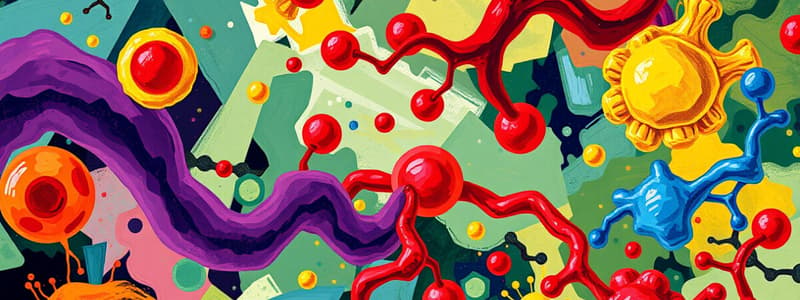Podcast
Questions and Answers
Which macromolecule is primarily responsible for carrying genetic information?
Which macromolecule is primarily responsible for carrying genetic information?
- Proteins
- Lipids
- Nucleic Acids (correct)
- Carbohydrates
Which metabolic process involves the synthesis of molecules and requires energy?
Which metabolic process involves the synthesis of molecules and requires energy?
- Glycolysis
- Krebs Cycle
- Catabolism
- Anabolism (correct)
What is the primary function of enzymes in biochemical reactions?
What is the primary function of enzymes in biochemical reactions?
- Store genetic information
- Accelerate chemical reactions (correct)
- Provide energy
- Regulate cell signaling
In which part of the cell does the Krebs Cycle occur?
In which part of the cell does the Krebs Cycle occur?
What structure is formed by nucleotides in DNA?
What structure is formed by nucleotides in DNA?
Which process is described as the breakdown of glucose to produce ATP?
Which process is described as the breakdown of glucose to produce ATP?
What role do hormones play in the body?
What role do hormones play in the body?
Which technique separates biomolecules based on size and charge?
Which technique separates biomolecules based on size and charge?
Flashcards are hidden until you start studying
Study Notes
Biochemistry Study Notes
Definition
- Biochemistry is the branch of science that explores the chemical processes within and related to living organisms.
Key Concepts
- Macromolecules: Large complex molecules essential for life, including:
- Proteins: Made of amino acids; function in structure, transport, enzymes, and signaling.
- Nucleic Acids: DNA and RNA; carry genetic information and are involved in protein synthesis.
- Carbohydrates: Sugars and starches; provide energy, structural support, and cell recognition.
- Lipids: Fats and oils; function in energy storage, membrane structure, and signaling.
Enzymes
- Definition: Biological catalysts that accelerate chemical reactions.
- Characteristics:
- Specificity for substrates.
- Can be regulated by inhibitors and activators.
- Function best at optimal pH and temperature.
Metabolism
- Anabolism: Metabolic pathways that construct molecules from smaller units; requires energy (e.g., synthesis of proteins).
- Catabolism: Metabolic pathways that break down molecules into smaller units; releases energy (e.g., glycolysis).
- ATP (Adenosine Triphosphate): Primary energy carrier in cells; produced during cellular respiration.
Cellular Processes
- Glycolysis: Breakdown of glucose to pyruvate, generating ATP and NADH.
- Krebs Cycle: Series of reactions that produce ATP, NADH, and FADH2; occurs in mitochondria.
- Electron Transport Chain: Sequence of proteins that transfer electrons and pump protons to create a gradient for ATP synthesis.
Genetics
- DNA Structure: Double helix formed by nucleotides; includes adenine, thymine, cytosine, and guanine.
- Gene Expression: Process by which information from a gene is used to synthesize proteins; involves transcription and translation.
Hormones and Signaling
- Hormones: Chemical messengers that regulate physiological processes (e.g., insulin, adrenaline).
- Signal Transduction: Mechanism by which cells respond to external signals; involves receptors, second messengers, and cellular responses.
Techniques in Biochemistry
- Chromatography: Separation of mixtures based on differential affinities.
- Electrophoresis: Technique for separating DNA, RNA, or proteins based on size and charge.
- Spectroscopy: Used to identify compounds and quantify concentrations.
Applications
- Medicine: Understanding diseases at a molecular level, developing drugs, and personalized medicine.
- Agriculture: Genetic modification and improving crop resistance.
- Biotechnology: Using biological systems for industrial processes, such as fermentation.
Important Scientists
- James Watson & Francis Crick: Discovered the double helix structure of DNA.
- Linus Pauling: Conducted research on protein structure and chemical bonds.
These notes cover essential concepts in biochemistry, providing a foundation for further study and understanding of biological systems at a molecular level.
Definition
- Biochemistry examines chemical processes in living organisms.
Key Concepts
- Macromolecules: Essential large molecules for life.
- Proteins: Composed of amino acids; roles include structural support, transport, enzymatic activities, and signaling.
- Nucleic Acids: DNA and RNA; essential for genetic information storage and protein synthesis.
- Carbohydrates: Sugars and starches that provide energy, structural support, and facilitate cell recognition.
- Lipids: Fats and oils; crucial for energy storage, membrane formation, and signaling.
Enzymes
- Biological catalysts that speed up chemical reactions.
- Exhibit substrate specificity and are modulated by inhibitors/activators.
- Function optimally at specific pH levels and temperatures.
Metabolism
- Anabolism: Builds large molecules from smaller ones, consuming energy (e.g., protein synthesis).
- Catabolism: Breaks down larger molecules into smaller units, releasing energy (e.g., glycolysis).
- ATP (Adenosine Triphosphate): Main energy carrier in cells, generated during cellular respiration.
Cellular Processes
- Glycolysis: Converts glucose into pyruvate, producing ATP and NADH.
- Krebs Cycle: Series of mitochondrial reactions that yield ATP, NADH, and FADH2.
- Electron Transport Chain: Protein sequence facilitating electron transfer and proton pumping to synthesize ATP via a proton gradient.
Genetics
- DNA Structure: Double helix formed by nucleotides (adenine, thymine, cytosine, guanine).
- Gene Expression: Information flow from genes to proteins via transcription and translation processes.
Hormones and Signaling
- Hormones: Chemical messengers like insulin and adrenaline that modulate physiological activities.
- Signal Transduction: The process of cellular response to external signals, involving receptors and second messengers.
Techniques in Biochemistry
- Chromatography: Separates mixtures based on their affinity differences.
- Electrophoresis: Technique for size- and charge-based separation of DNA, RNA, or proteins.
- Spectroscopy: Identifies compounds and quantitatively measures concentrations.
Applications
- Medicine: Advances in understanding diseases, drug development, and personalized medicine.
- Agriculture: Enhancements through genetic modification and crop resistance improvements.
- Biotechnology: Application of biological systems in industrial processes like fermentation.
Important Scientists
- James Watson & Francis Crick: Pioneers of the double helix DNA structure discovery.
- Linus Pauling: Known for research on protein structure and chemical bonding theories.
Studying That Suits You
Use AI to generate personalized quizzes and flashcards to suit your learning preferences.



